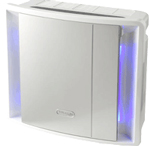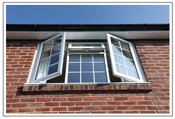

Buying a dehumidifier to cure condensation ?
If your home suffers from excessive humidity leading to damp walls and mould an obvious answer might be to buy a dehumidifier, as a short term or even long term solution.
However we don't think a dehumidifier is the best way to solve condensation. Why ?
1. They treat the symptoms, not the problem.
Buying a dehumidifier is a bit like treating a cold with a handkerchief. They will help but they do not address the cause of the problem. About half the homes we are asked to inspect have a dehumidifier in problem rooms.
Put simply, if dehumidifiers are an effective solution we probably wouldn't be asked to a home in the first place.
2. They do not remove indoor pollutants
You will need a separate - and probably more expensive - unit in the form of an air purifier if you actually want to remove some but not all pollutants from a room. As with dehumidifiers, these units require power to run and are not completely silent.

The job of a dehumidifier is simply to extract moisture from the air and will not remove the indoor pollutants in our homes. Homes that suffer from condensation and mould have a large number of mould spores in the air. This is why homes with mould have a 'fusty' stale smell. Mould spores usually exacerbate symptoms for people with breathing difficulties like asthma.
In addition to mould spores there are a range of other pollutants in our home (see our page on hidden air pollution) including dust and FOCs.
3. They are more expensive to run than extract fans
Electrical dehumidifiers use a compressor to extract moisture from the air. A typical unit might consume around 280W - although they would not necessarily be running all the time. They also generate a small amount of noise so might not be suitable for bedrooms.
4. They are not a 'whole house' solution
A dehumidifier will give some benefit to the room that its in but will have a limited benefit beyond that. For that reason many homes we survey have more than one unit running in an attempt to keep on top of the humidity.
Master bedrooms are often the room in the house that first suffers from condensation and mould. We find occupants often have a dehumidifier in one or more bedrooms.

5. They are not working at the right time of day
Dehumidifiers tend to be switched on during the day, but are off overnight. But humidity can be a problem overnight and less so during the day. At night all - or most of the family are home. The heating is off and so temperatures fall. In bedrooms this is when condensation starts to form and damp walls encourage the growth of mould.
In the morning windows are opened, dehumidifiers and central heating are switched on. Unfortunately it is during night that the damage is done.
There is a better way
Dehumidifiers seem to be the obvious way of reducing humidity, removing condensation, stopping walls becoming damp and preventing mould.
But a more effective solution is to give your home a small but consistent background movement of fresh air. This will help keep your home feeling fresher, healthier and mould free.
High humidity + inadequate ventilation
= damp, condensation, mould

UK government advises:

